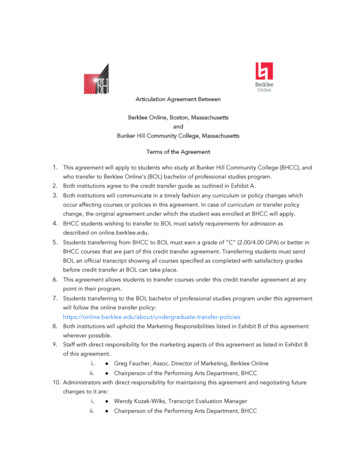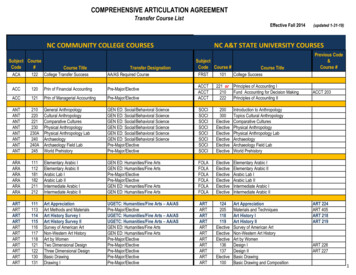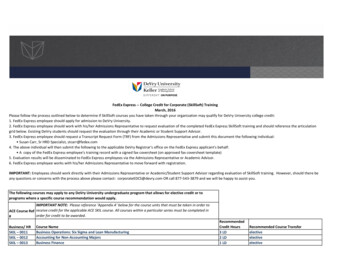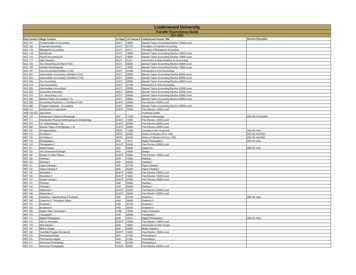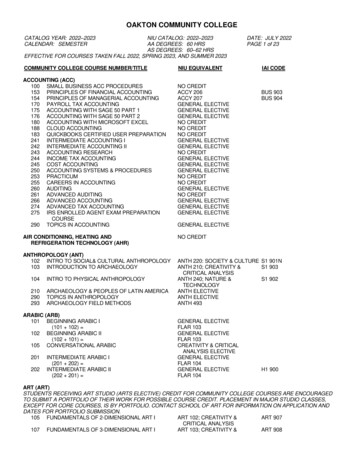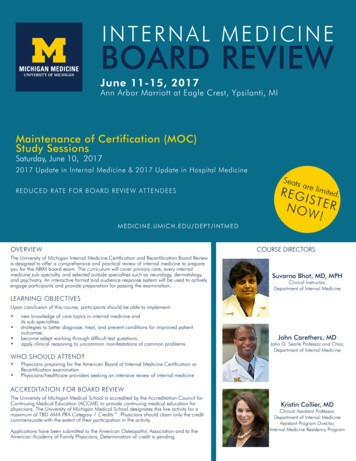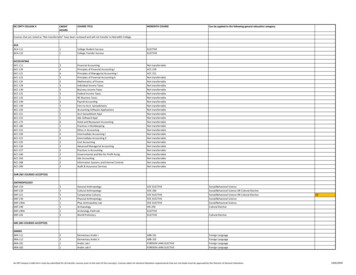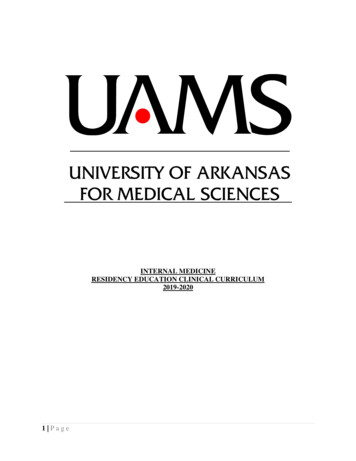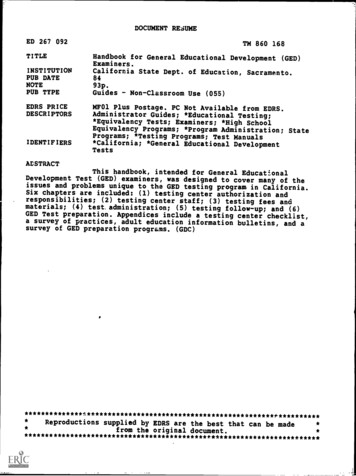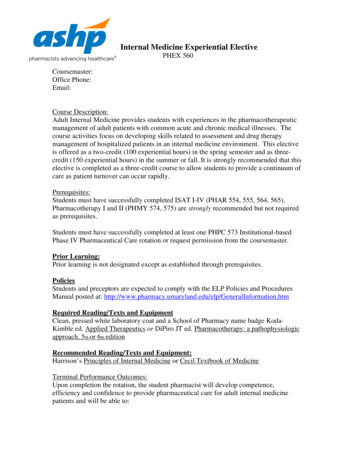
Transcription
Adult Internal Medicine Experiential ElectivePHEX 560Coursemaster:Office Phone:Email:Course Description:Adult Internal Medicine provides students with experiences in the pharmacotherapeuticmanagement of adult patients with common acute and chronic medical illnesses. Thecourse activities focus on developing skills related to assessment and drug therapymanagement of hospitalized patients in an internal medicine environment. This electiveis offered as a two-credit (100 experiential hours) in the spring semester and as threecredit (150 experiential hours) in the summer or fall. It is strongly recommended that thiselective is completed as a three-credit course to allow students to provide a continuum ofcare as patient turnover can occur rapidly.Prerequisites:Students must have successfully completed ISAT I-IV (PHAR 554, 555, 564, 565).Pharmacotherapy I and II (PHMY 574, 575) are strongly recommended but not requiredas prerequisites.Students must have successfully completed at least one PHPC 573 Institutional-basedPhase IV Pharmaceutical Care rotation or request permission from the coursemaster.Prior Learning:Prior learning is not designated except as established through prerequisites.PoliciesStudents and preceptors are expected to comply with the ELP Policies and ProceduresManual posted at: mation.htmRequired Reading/Texts and EquipmentClean, pressed white laboratory coat and a School of Pharmacy name badge KodaKimble ed. Applied Therapeutics or DiPiro JT ed. Pharmacotherapy: a pathophysiologicapproach, 5th or 6th editionRecommended Reading/Texts and Equipment:Harrison’s Principles of Internal Medicine or Cecil Textbook of MedicineTerminal Performance Outcomes:Upon completion the rotation, the student pharmacist will develop competence,efficiency and confidence to provide pharmaceutical care for adult internal medicinepatients and will be able to:
1.2.3.4.Maintain a pharmaceutical care database on all assigned patients whilerecognizing the specific needs of hospitalized patients in internal medicine.a.Develop a relationship with the patient/caregiver(s) and health careprofessionals caring for the patient.b.Gather relevant information by reviewing medical records andinterviewing the patient/caregiver.c.Identify the pathophysiologic states, pharmacokinetic parameters, andlaboratory parameters through discussions with preceptors providing careto hospitalized internal medicine patients.Identify and assess those patients who require a change in pharmacotherapy.a.Identify and assess problems for which pharmacotherapy may beindicated.b.Identify any adverse drug reactions or medication errors and document.c.Assess current treatment regimens.Develop and implement pharmaceutical care plans specific to hospitalizedinternal medicine patients.a.State the desired and achievable pharmacotherapeutic goals for eachidentified problem.b.Make appropriate drug therapy decisions by integrating patient-specificdata with drug disease information. Drug-specific information that must beconsidered include the comparative efficacy, pharmacokinetics, toxicity,appropriate dosage form, and costs of available agents. Decisions may beto select, recommend, adjust, or discontinue drug therapy.c.Design and record drug therapy monitoring plans that state the parametersto be measured and frequency of measurement, including measures oftherapeutic response and toxicity.c.Provide appropriate pharmacologic and non-pharmacologic treatmentrecommendations.d.Recommendations will be supported by primary literature and/or inaccordance with national guidelines.Educate patients/caregivers and health care professionals regarding the2
appropriate use of drugs in common acute and chronic medical illnesses in adults.5.a.Implement patient-specific educational plans. Such plans should includedirections for use/administration, storage, purpose, potential adverseeffects, and drug interactions with prescription, over the counter andherbal products of medications prescribed or recommended.b.Educate professional colleagues, including pharmacists, physicians,nurses, and dieticians, regarding drug therapy using formal and informalmethods. Formally present to a group of colleagues an organized patientcase and discuss the important drug therapy issues related to the case.c.If facilitating patient transitions from one care setting to another, assist byobtaining prescriptions and by communicating the pharmaceutical careplan to another pharmacist and/or health care provider(s).d.Communicate effectively during professional interactions including butnot limited to preceptor meetings, journal clubs, committee meetings, andprofessional gatherings.Measure and document patient outcomes.a.Implement pharmaceutical care monitoring plans to determine theoutcome(s) of drug therapy. Measure and record the therapeutic responseand toxicity.b.Modify pharmaceutical care plans appropriately based on data collectedfrom patient monitoring or when other data becomes available.c.Identify, assess, and report adverse drug reactions (ADR’s) andmedication errors using the appropriate reporting system.Activities1. The student will be assigned to a preceptor, who will orient the student to the siteand site procedures for documenting patient records. Together they will determinethe schedule of activities which support the terminal performance outcomes.2. Students will collect data from patients, healthcare providers, and the literature inorder to evaluate therapeutic efficacy and the potential for drug-induced toxicityin patients whom they are assigned to monitor.3. Students will fully monitor 5 to 15 patients at a time, and therefore it isrecommended that days on rotation for a two-credit rotation be scheduledconsecutively.4. Students must write daily SOAP notes for at least eight patients during theirrotation. A copy of at least one SOAP note per patient should be included in the3
student’s portfolio. Students should identify therapeutics objectives, monitoringparameters and plan.5. Students will attend rounds daily and/or be an integral part of the generalmedical service team and will attend grand rounds, conferences, attending rounds,or other applicable teaching rounds as assigned by preceptor.6. Students will provide at least one in-service to the medical team or pharmacystaff on selected drug therapy topics approved by the preceptor. A copy of the inservice will be included in the student’s portfolio.7. Students will meet with the preceptor a minimum of three times per week todiscuss patient care, pertinent pharmacotherapeutic topics, and assigned readings.8. Students will record interventions and outcomes of interventions made duringrotation (with the preceptor’s prior approval) by classifying interventions intoone of the following categories: untreated indication; drug use without indication;improper drug selection; failure to receive drug; sub-therapeutic dose; overdose;adverse drug reaction; drug interaction; improper route; improper monitoring;formulary management issues; and patient education. Intervention lists will beturned in to the preceptor at the end of rotation and the student will place a copyin his/her portfolio. (Students should used attached intervention sheet or oneprovided by preceptor)9. Students will provide discharge counseling to at least two patients per week.Students should document discharge counseling in the patient’s medical chart inaccordance with the individual institution’s guidelines. A copy of two dischargecounseling notes will be placed in the student’s portfolio (patient identifiersshould be removed).10. Students will obtain a medication history (including drug allergies andintolerances with reactions, previous pertinent medications taken) and studentshould evaluate compliance from at least two patients per week. A copy of twomedication histories will be placed in the student’s portfolio (patient identifiersshould be removed).Student Assessment:The student will be assessed by the preceptor on performance and professionalism at themidpoint and at the end of the rotation. The mid-rotation evaluation will not be used inthe calculation of the student’s grade. The preceptor’s evaluations will be recorded andorally communicated to the student. The original evaluation forms (both mid-rotationand final) must be returned by the student to the Experiential Learning Office within 7days after completing a rotation. The student will retain a copy of the evaluation inhis/her portfolio. Students will receive a letter grade. The lowest passing letter grade is a“C”.Performance:The preceptor will assess the student using the syllabus evaluation formBehavior:4
Students must achieve acceptable ratings for all four professionalism criteria inorder to pass the course.Letter Grade:The letter grade is determined by the percentage of total points earned for thecombined objectives.Points90-100% of total points80-89% of total points70-79% of total points0-69% of total pointsLetter GradeABCFPreceptor Assessment:The student will complete and submit the Phase VI Student Evaluation ofSelf/Site/Preceptor Performance no later than seven days following the completion of therotation. Each summer, preceptors will be provided summaries (no student namesincluded) of their evaluations in order for them to improve rotations. If a preceptor hashad only one student during the previous year, no summary will be sent.Preceptor Qualifications and Responsibilities:The preceptor must have a clinical faculty appointment from the University of MarylandSchool of Pharmacy. The preceptor will be qualified to teach this rotation with a PharmDand BCPS, or BCNSP, or a completed pharmacy practice residency, or a specialtyresidency, or relevant clinical experience as determined by the coursemaster. He or shewill offer in-depth internal medicine student opportunities either through a generalmedical service team in a teaching hospital or a general medicine area in a communityhospital. Preceptors will provide the coursemaster with current resume or curriculumvitae and a letter of recommendation prior to precepting students.The preceptor is responsible for the guidance, supervision, and assessment of the studentin the day-to-day conduct of the course. The preceptor will develop a learning contract toinclude site-specific requirements, such as expectations, the rotation schedule, readings,and assignments.The preceptor will provide the student with a written and verbal midpoint and finalevaluation. The preceptor will assess the student at the midpoint to provide the studentwith constructive feedback. At the midpoint evaluation, if the student is not meetingexpectations, the preceptor will be responsible for providing this information to thecoursemaster. The final written evaluation will include examples or reasons to supportgrade given to the student. It is also strongly recommended that the preceptor routinely(at least weekly) provides verbal evaluation of the student’s progress toward goals.5
Preceptor’s Evaluation of StudentPHEX 560 Adult Internal MedicineStudent’s Name (Print):Preceptor’s Name (Print):Site Name (Print):Rotation Start Date:Midpoint Evaluation Date:Final Review Date:NOTE: The student and preceptor sign this form to attest that the course objectives,including the required hours of participation, were accomplished and that the assessmentwas discussed. This does not necessarily indicate the student’s agreement with theassessment. It is the STUDENT’S responsibility to submit the completed originalevaluation form to the Office of Experiential Learning. The student and the preceptorshould retain a copy of the completed evaluation.I have reviewed this evaluation with the student:Preceptor’s Signature and DatePreceptor’s Comments:6
I have reviewed this evaluation with my preceptor. My signature does not necessarilyimply agreement with the evaluation, only that it has been reviewed with me and Iunderstand the preceptor’s basis for the evaluation.Student’s Signature and DateStudent’s Comments:Definitions:O Outstanding: The student is able to perform all of the skill’s elements withminimal assistance from the preceptor. Also, the student is able to verbally justifyhis/her actions and decisions. Point Value: 10A Acceptable: The student is able to perform the skill but requires assistancefrom the preceptor for some of the skill’s elements. Point Value: 8N Not acceptable: The student is unable to perform the skill without assistancefrom the preceptor for all or most of the skill’s elements. Point Value: 0MidEvalTerminal Performance Objectives1. Maintain a pharmaceutical care database on allassigned patients while recognizing the special needs ofthe hospitalized internal medicine patient.¾ Collect pertinent and accurate subjective (CC,HPI, ROS, FH, and SH) data from thepatient/caregiver.¾ Collect a complete and accurate medicationhistory and drug allergies and intolerance listfrom the patient/caregiver (including dose, route,frequency, start date etc. and pertinentmedications used in the past)¾ Collect pertinent and accurate subjective andobjective (PE, LAB, and test results) data fromthe medical chart.¾ Identify pertinent issues from pharmacokinetics,laboratory parameters, and pathophysiology.ENTER O, A, NComments:7FinalEval
2. Identify and assess those patients who require achange in pharmacotherapy.¾ Identify problem list consistent with patientdatabase and does not contain signs/symptoms.(List asthma instead of wheezing, SOB.)¾ Identify adverse reactions or medication errors.¾ Assess each problem commenting on stability,control, etiology, risk factors present, severity,and need for treatment.¾ If currently receiving treatment, assess therapy.3. Develop and implement pharmaceutical care plans.¾ List therapeutic goals for each problem.¾ After considering patient- and agent-relatedvariables, recommend drug and non-drugtreatment for each problem (include dose,frequency, and duration) that will likely meettherapeutic goals and discontinue therapies ifneeded.¾ Develop and implement (with preceptor priorapproval) monitoring plan that will evaluatetoxicity and efficacy of the treatment regimen.¾ Uses primary literature or national guidelines tosupport recommendations.4. Educate patients and health care professionalsregarding the appropriate use of drugs in common acuteand chronic medical illnesses in adults.¾ Educate the patient/caregiver on the treatmentplan using materials and language that isappropriate to the level of education.¾ Respond appropriately and accurately toquestions from patients, caregivers, andhealthcare providers (MD, RN, etc).¾ If facilitating patient transitions, communicatethe treatment and monitoring plan to appropriatehealthcare providers such as pharmacists.ENTER O, A, NComments:ENTER O, A, NComments:ENTER O, A, NComments:8
5. Measure and document patient outcomes.¾ Document interventions and recommendations informat that conforms to practice site’s standard(i.e., SOAP in chart, pharmacy system).¾ Document patient response to treatment plan infollow up SOAP notes and update treatment andmonitoring plan as needed.¾ Correctly complete practice site’s ADR /medication error report as needed.¾ Correctly record list of interventions and turninto preceptor at the end of rotation.ENTER O, A, NComments:Circle Rating:6. In-Service PresentationOOutstandingAcceptableNotacceptableIn addition to meeting criteria for Acceptable, thestudent does all of the following: Maintains frequent eye contact with the audience. Presents materials appropriate to the audience. Presents the topic in an organized manner. States how the material is relevant to clinicalpractice. Answers almost all ( 90%) questions posed bythe audience correctly.The student does all of the following: Speaks using a volume, rate, and quality ofspeech that is understood by the audience. States action-oriented learning objectives for thepresentation. Presents accurate information. Submits a referenced handout (following UniformRequirements) that supports the presentation. Finishes within the allotted time. Answers most ( 50%) questions posed by theaudience correctly.Does not meet all criteria for Acceptable as statedabove.A*Comments:9N
Total Points ( 60 Max):PROFESSIONALISM AND BEHAVIOR:ACCEPTABLE RATINGS ARE REQUIRED FOR ALL FOUR CRITERIA .MidpointFinalITEM 1: PATIENT AND PROVIDER COMMUNICATIONSAcceptableThe student consistently (greater than 90%): (1)Introduces self at first encounters; (2) Greetspatients and other health care professionals with asmile and/or positive inflection in voice; (3)Guards patient information from disclosure andseeks permission to disclose information to otherparties (e.g. family, other health careprofessionals); (4) Demonstrates effectivelistening skills (good eye contact, non-verbalcues); AND (5) Speaks effectively andrespectfully (e.g. not condescending, sarcastic,meek, nor overly-assertive).Notacceptable(1) Does not meet criteria for acceptable as statedabove; OR (2) The student inappropriatelydisclosed patient information on more than 1occasion; OR (3) The student made negative orinappropriate public remarks about colleagues orpatients on more than 1 occasion.ITEM 2: APPEARANCE, lThe student consistently (greater than 90%): (1)Comments:Wears clothing that is professional in appearance(e.g. appropriate to the culture of the institution asdefined by the preceptor, site dress code, andprofessional norms); (2) Minimizes wearing ofjewelry in patient care areas; (3) Is well-groomed;AND (4) Wears name badge.Does not meet criteria for acceptable as statedabove.10
ITEM 3: TIMELINESS, COMMITMENTAcceptableNotacceptableThe student consistently (greater than 90%): (1)Completes assignments on or before deadline; (2)Arrives on time; (3) Calls/notifies preceptorwhen unable to meet deadline or arrive on time;(4) Gives high priority to completing courserequirements during allotted rotation hours; AND(5) Arrives prepared with equipment andassignments as directed.(1) Does not meet criteria for acceptable as statedabove; OR (2) The student completes someresponsibilities in such an untimely manner that itjeopardizes patient health or institutionalefficiency.ITEM 4: INITIATIVEAcceptableNotacceptableThe student consistently (greater than 90%):(1) Accepts responsibility and demonstratesaccountability without repeated reminders; (2)Demonstrates a sense of duty; (3)Demonstrates an earnest desire to learn; (4)Demonstrates the willingness and flexibility tocontribute to thewell-being of others; AND (5) Appliesknowledge, experience, and skills to the best ofhis/her ability.Does not meet criteria for acceptable as ments:Revised January 200611
Student Name:DatePtIDRx/non-Rx involved(include dose,frequency and N &why?)Treatmentdiscontinuation((Y/N) &Why?)Otheraccepted(Y/N)?If not, why
Harrison's Principles of Internal Medicine or Cecil Textbook of Medicine Terminal Performance Outcomes: Upon completion the rotation, the student pharmacist will develop competence, efficiency and confidence to provide pharmaceutical care for adult internal medicine patients and will be able to:
